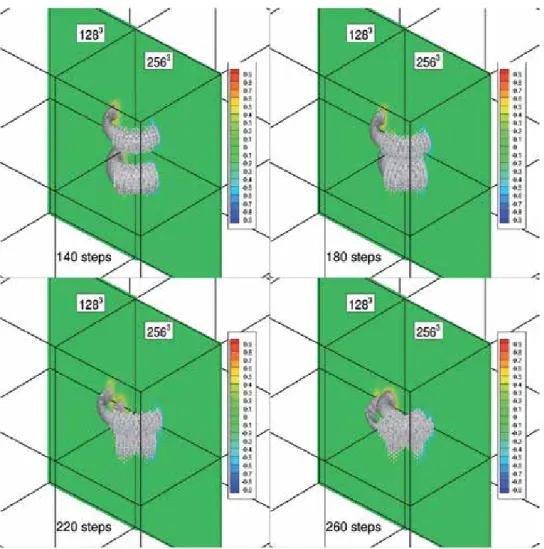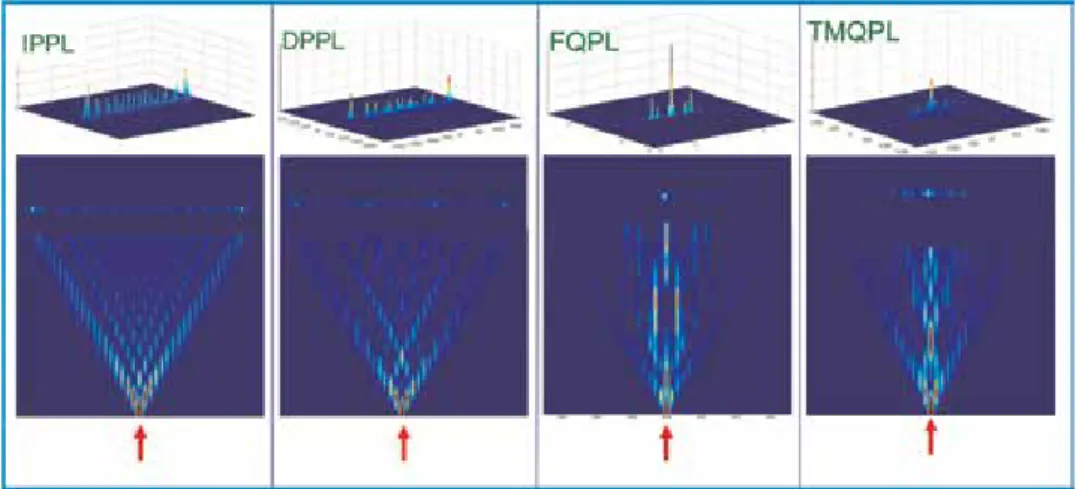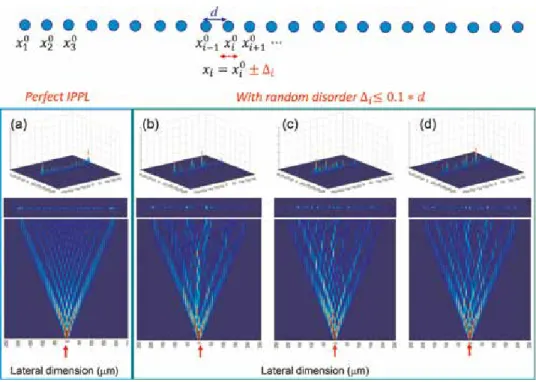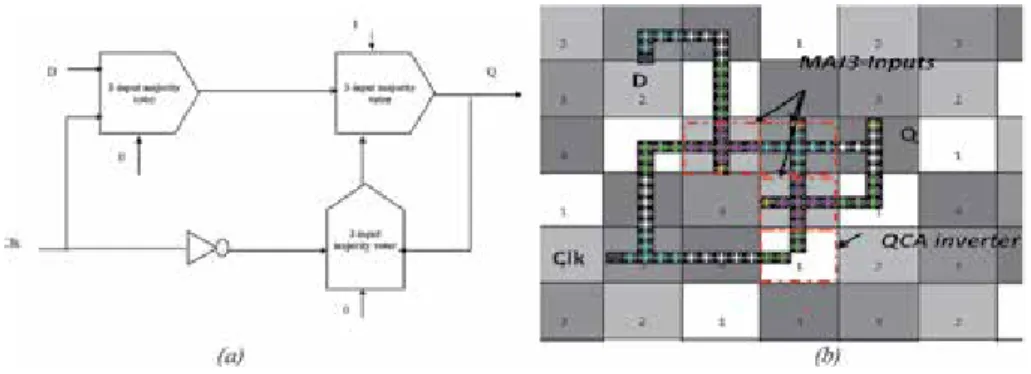The material part of the transmission is created in the transceivers through their solid state. If the positions of the stego image and the auxiliary empty quantum text are the same, and GRAY S� 7YXS6YXS5YX�.

Introduction
The key innovation in these developments is the design that targets the execution of the algorithm fully on the quantum processor. In particular, at the start of the simulation, several quantum states in the quantum processor will be initialized.
Elements of quantum computing relevant in current work
Mapping a computational problem onto the quantum state vector
During the quantum simulation, the quantum state is transformed by the application of quantum gates in quantum circuits. It follows that log 2 N qubits will be sufficient to create the required number of degrees of freedom in the quantum state vector.
Approximate quantum Fourier transform (AQFT)
Specifically, for each qubit added to the coherent register, the number of degrees of freedom doubles. After a mapping of the considered computational problem to the quantum state vector has been designed, the computations are then performed through the application of quantum gates as in the quantum circuit model.
Hybrid quantum/classical vortex-in-cell method
In the following, we define the approximation or "band-limit" in the AQFT as follows. These example results show what level of approximation in the QFT is acceptable for application of the VIC method.
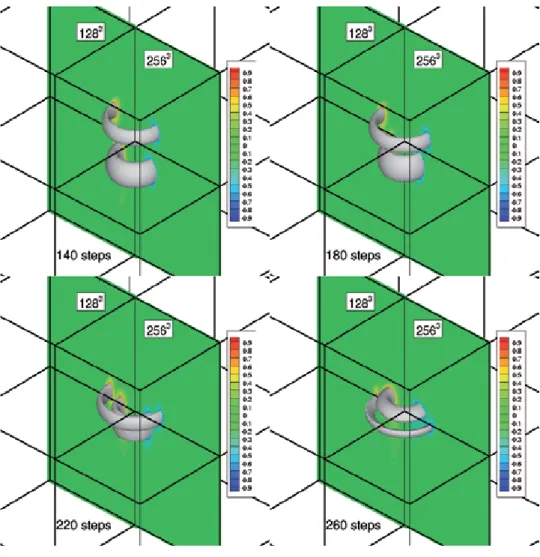
Quantum algorithm for discrete-velocity method
Quantum circuit implementation of specular-reflection boundary conditions A key aspect of the flows simulated by the quantum algorithm described here
As an example, Figure 8 shows the quantum path implementation of the specular reflection for a rectangular body. The negation operation ("X") is applied to the qubits representing the velocity mesh index to create the "change of sign" of the considered discrete velocity data.
Circuit implementations using ancilla qubits
This circuit is shown as an illustration of the quantum algorithm design approach used here. As is typical in this context, we assume that the ancillary qubits are initially in |0>, and since these must be reused multiple times, the transformed circuits must reset the ancillary qubits from this state at the end of the operations.
Conclusions
This measure is based on the Wigner representation in phase space of non-Gaussian states. The graph in Figure 3candd shows the behavior of the NWF as a function of j jα for the non-Gaussian system (2). We have shown that the negative parts of the Wigner function can be used as a detector of non-Gaussian interlacing.
The results show that the behavior of the QWs is very different depending on the inlet position. In this way, the carry (Cout) is then transmitted to the carry in (Cin) of the next high-order bit. Implementation and simulation of the proposed hardware models is achieved using the QCADesigner 2.0.3 tool [45].
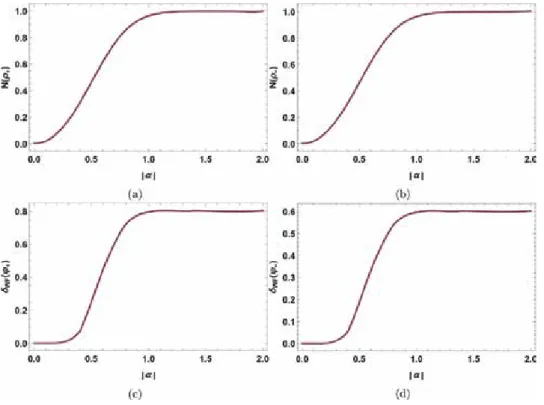
Computational section
Overview of computational quantum chemistry
Multiple papers have been presented using hydrophobic ionic liquids and DES for extraction of potential endocrine descriptors such as diethylstilbestrol, bisphenol-A and dichlorodiphenyltrichloroethane (DDT) [6]. However, less emphasis is placed on compounds such as estrone and other estrogen-based endocrine-disrupting compounds in general. Ab initio-based quantum chemistry methods attempt to solve the Schrödinger equation to extract intricate details such as electron distribution, underlying molecular interaction and reactivity in a proposed virtual environment.
In this work, we employ ab initio calculations using comparative computational procedures to study the interactive behavior of estrone and ionic liquids such as [BMIM]+[NTF2]-, [BMIM]+[PF6]-, and [BMIM]+[BF4]-.
Computational details and methodology
Recent advances in computational facilities have paved the way to run these simulations in a much faster way and have also enabled theoretical chemists to solve a variety of problems in disciplines ranging from spectroscopy [7] to solvent extraction [8]. This study is intended to be a primer to understand the affinity of estrone to theoretically validate whether the solvent is a potential extractor when commercially used in standard liquid-liquid extraction procedures.
Results and discussion
Optimized structures of the complex at the B3LYP/6-31G(d) level
Assuming the Born-Oppenheimer approximation, the relative velocity of the nuclei is considered negligible and so is its contribution to the kinetic energy of the system. The DFT methods used in the present scenario describe the changes in the total energy of the system, through the exchange and correlation of electrons and electrons and nuclei using hybrid functionals. The interacting monomers, namely, estrone and each of the three ionic liquids [BMIM]+[NTF2]-, [BMIM]+[PF6]- and [BMIM]+[BF4]-, were constructed using Gaussview6 [13] and optimized separately at the B3LYP/6-31G level, using the corresponding programs found in [4-31G]. energy in the ground state.
Since not all binding parameters of the monomers are known, none of them were constrained by optimization.
Interaction energy calculations
These results suggest that electrostatic interactions and other closed-shell interactions between atoms with complementary polarities are predominant compared to the effects of covalent interactions and π-cloud effects contributed via the imidazolium ring. Interaction energy calculations provide a numerical estimate of the ability of the EDC to interact with the ionic liquid by means of chemisorptions occurring at the molecular level. Negative values indicate good interaction behavior of estrone in the presence of the ionic liquid.
In comparison, it can be seen that [BMIM]+[PF6]- and the estrone system bind the complex with stronger interaction strength contributing to the highest negative binding energy of -9.57 kcal/mol.
Atoms in molecule (AIM) analysis
Conclusions
One of the most famous cats in science has to be Schrödinger's cat in quantum mechanics, where the cat can be either alive or dead at the same time unless we look inside Schrödinger's box. The life of Schrödinger's cat has puzzled quantum physicists for over eight decades, as Schrödinger revealed it in 1935. I will show that Schrödinger's cat can only be either alive or dead, but not at the same time, regardless of whether we look into Schrödinger's box or not.
For example, science has evolved from Newtonian mechanics to Einstein's theory of relativity and to Schrödinger's quantum mechanics.
Flaws of a physical model
Every proven science within our temporal universe is physically real; otherwise it is fictitious unless it can be repeated through experimentation. Using exact math to evaluate imprecise science does not guarantee that the solution exists within our temporal subspace. On the other hand, each atom model as presented in Figure 2 is physically real, in which we see that a Bohr atom is embedded in a temporal (time-dependent) subspace (e.g. our universe).
On the other hand, as referred to Figure 2, a temporal (time-dependent) atomic model embedded within a time-dependent (or temporal) subspace is a physically realizable model, in which we see that the temporal or causality requirement (i.e. t > 0) imposed by our temporal subspace is included.
Schrödinger’s equation
Pauli exclusive principle and particle entanglement
Schrödinger’s cat
And we can see that "instantaneous" (ie, t = 0) entanglement between particles is "fictitious" and would not occur within our temporal space. The box is assumed to be completely dark, for which we do not know whether the cat will be killed or not, as imposed by Schrödinger's superposition principle, until we open the box. This tells us that the principle has itself created a quantum subspace without time (ie, t = 0) or time-independent quantum space.
This conjecture tells us that the hypothetical radioactive material cannot actually exist in the box, since both quantum states (i.e., decay or non-decay) cannot occur simultaneously in a time-dependent subspace.
Paradox of Schrödinger’s cat
But as soon as we open the box, the superposition state of the radioactive particle collapses without proof. Let's accept for a moment what is considered a fundamental principle, so that inside the box there is a superposition of a radioactive particle with a dual quantum state. Let us replace the binary radioactive particle with a tossed coin in the Schrödinger box shown in Figure 4.
Then Schrödinger's cat can only be either dead or not dead, but not at the same time, in which we see that there is nothing to do whether we open the box or not to collapse the fundamental principle.
Essence of a subatomic model
Let us now go back to the half-lived cat in Schrödinger's box, where the radioactive particle is assumed to be inside a timeless sub-box as shown in Figure 5, in which we see that a timeless (i.e. t = 0) radioactive particle is located inside the time-dependent (i.e. t > 0) box, which is "not realizable" postulation cat for Schrödinger. Schrödinger's is not a paradox, since the postulated superposition is timeless, and it is not a physically realizable principle within our temporal universe. Finally we found the error of Schrödinger's cat, where Schrödinger was not supposed to introduce a timeless radioactive particle into the box.
I think we have finally found the root of the paradox of Schrödinger's cat, that we must leave the cat with a story to tell; once upon a time there was a cat with a half life.
Timeless quantum world
This intrigues us looking at Schrödinger's equation, which was developed on an empty (ie t = 0) subspace platform, where we see that the superposition position collapses as soon as we open Schrödinger's box. And the postulated Schrödinger's cat is not a physically realizable solution, where we have shown that the burden of the cat's half-life can be released by using a temporal (ie t > 0) radioactive particle instead, in which we see that the paradox of Schrödinger's cat may never be discovered, that it is not a paradox that Schrödinger's time is not a mechanism if we discovered that Schrödinger's time is without mechanics. We see that forcing a timeless (ie t = 0) solution into a temporal (ie t > 0) subspace would predict a paradoxical solution that does not exist in our temporal universe, such as Schrödinger's half-lived cat.
This is equivalent to chasing a ghost of a timeless half-life cat in a temporal subspace, in which we have discovered that a timeless radioactive particle has been placed in Schrödinger's box.
Math and temporal (t > 0) space duality
For example, those promises of instant and simultaneous response from the fundamental principle do not exist within our temporal space. Any physical science that exists in our time subspace must be temporal (ie, t > 0); otherwise, it is a virtual (or fictitious) science as mathematics does. Therefore, it is a serious mistake to assume that the principle of superposition works within our temporal universe, such as the paradox of Schrödinger's cat and perhaps others.
Since the timeless subspace is assumed to be within a temporal (i.e. t > 0) space, it is the temporal space that dictates the end response, as shown in Figure 10e.
Quantum mechanical assessments
Remarks
One of the main problems of these theories is also the locality of a particle in the space-time frame. Widely separated regions of space carry non-uniform energy storage within the space-time frame. Model (2) describes the conjugation of particles of force (Eap) and matter (Es), forming the spatio-temporal framework of a matter.
2Yþeþ=e�þνe=νe�¼eþ=νeþe�=νe� (9) The coupling reaction (9) preserves the conservation of energy and momentum within the bounded space-time frame. The process moves in the direction of expanding the space-time frame of observable matter. The merging of quanta of energy with the created space-time leads to the expansion of the space of an event.


